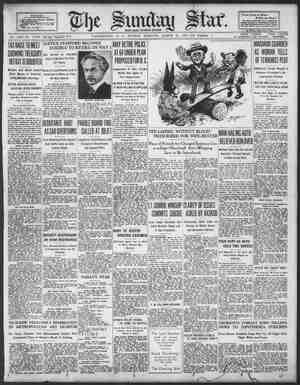Evening Star Newspaper, March 22, 1931, Page 76
You have reached the hourly page view limit. Unlock higher limit to our entire archive!
Subscribers enjoy higher page view limit, downloads, and exclusive features.
The Last of a Series of Articles on Egypt BY GIDEON A. LYON. Photographs by the Author. OURISTS are easily spotted in Egypt’ Indeed, there is prebably no place on earth where the stranger traveler can without positive disguise conceal his identity from the native population, A difference in garb, a difference in features, in bearing, in what may be generally called style, stamps one for indentification as the visi- tor, presumably with cash to spend for services and for goods. In Egypt the male tourist, who rarely adopts native garb, and to whom the tarboush is simply a bit of fancy-dress affecta- tion, is an especially easy mark, for he almost invariably carries about with him one of the three essentials to complete tourist happiness— a guide book, a pair of bipoculars, & camera. He may not carry all three at once, but he is rarely without one of them. Of these three cutward marks of the tourist the camera is the most certain to attract and hold the attention of the native public. It is not because cameras are rare, for people have been photographing in Egypt from the earliest days of the art. But there is something about the small black box—and particularly the vari- colored styles of cameras de luxe that smart manufacturers have offered for ladies’ use— that fascinates the native. Let a tourist with a ‘camera stop at an attractive vantage point and unsling his machine and traffic slackens, business is suspended and a group of immediate bystanders assembles. Tens, perhaps hundreds of thousands of camera-tourists have wandered through the streets of Cairo during what may be called the flh SGNDAY STAR, mmncro_u,-_.n. €, MARCH 2, 1931 TOURING EGYPT WITH A CAMERA The Traveler Cannot Hide His Hen- tity and \theffifhétogmpher Usually Draws a Crowd—Difficulties Encountered in Obtaining P)zétogmphs. ' and persuade them to resume their _bystanders usual walks of life. My own camera in Egypt was one of the loudly self-advertising kind. It opened up with a séries of finger piessures and flips until it appeared to be twice as big when ready for action as at the start. That procedure always drew the admiring attention of those close at hand and eventually of the distant spectators. But I did not want their plaudits or apprecia- tion. I wanted a clear vista, and that was hard to get. It is maddening to get all set in a favorable position, with the light falling just right on an attractive subject;, get the picture perfectly focused in the viewfinder and then snap the shutter, only to discover on looking up that at the final moment some curious one has stepped directly in front of the lens, close up. Of course, the picture is ruined. But sometimes that is not discovered until the negative been developed and printed, and then it i necessary to go back scene again and, if the light is right, Perhaps even then some The tarbousherie workers of Cairo pose for the camera. A seller of sweetened drinks in Caires intruder will delay the proceeding or even for a second time spoil the shot. The extra fast shutter is not a defense against such invasions of the field. When working a hooded viewfinder machine one requires & third eye to watch the crowd while adjusting focus and iris. I reached the conclusion that the particular need of the photographer in the streets of Cairo was an intimate knowledge of the psychology of the Egyptian, and that can be gained only by protracted contact. There was one subject that I especially sought in the native sections of Cairo. This was the “walking five-and-ten-cent store.” g 9.;‘ 5.8 4 : 53 -3 it il | -street into another I encountered an organ grinder and a lttle girl with s tambourine. Probably they were true gypsies, ilthough they have been Italians. I wanted to “shoot® of the organ drew a erowd little girl danced so vigorously gi-i i i i j b I
